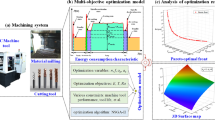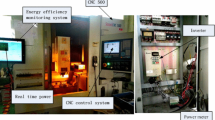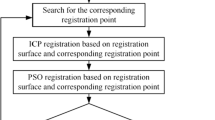Abstract
Machining process parameters (MPP) directly affect the machining quality and efficiency of heavy-duty CNC machine tools (HCMT). The selection of MPP is very important to effectively improve machining performance. Machining performance has been closely related to the HCMT running state. In order to maintain HCMT sustainably manufacturing with high accuracy and low consumption after machining performance degradation for a long time running, MPP should be re-optimized according to the current state of the machine tools. Thus, this paper proposed a MPP optimization method for running HCMT to obtain optimal MPP based on current running state. A multi-objective optimization model was built, considering both the linear factors such as machining time and machining cost and nonlinear factors such as chatter in machining process. The nonlinear factors were reflected by the nonlinear dynamic model of machining process. Furthermore, a grid optimization algorithm was introduced to search the optimal MPP from the multi-objective optimization model. Finally, a case study was implemented to verify the feasibility of the nonlinear dynamic model and the superiority of the multi-objective optimization method compared with single-objective optimization method.
Similar content being viewed by others
References
Wang TY, Wang WJ, Fan SB, Dong TJ, Li HW, Qin XD (2004) The simulation of the milling optimization parameters for CNC cutting system using self-adaptive genetic algorithms. Manuf Autom 26(8):28–30
Liu M, Chen WL, Zhai JJ (2002) Research on the optimization of machining parameters for milling operations. J Yancheng Inst Technol (Na Sci) 15(01):38–40
Michalewicz Z, Schoenauer M (1996) Evolutionary algorithms for constrained parameter optimization problems. Evol Comput 4(1):1–32
Jiang S (2006) Research on NC cutting parameter optimum matching expert system, Tongji University
Jiang B, Yang SC, Zheng ML (2002) Multi-goal optimization of NC cutting parameters. Tool Eng 36(7):22–25
Shen H, Xie LM, Han Y (2005) Multi-target optimization of cutting parameters in NC turning. Journal of Lanzhou Univ. of Tech 31(05):47–49
Abburi NR, Dixit US (2006) A knowledge-based system for the prediction of surface roughness in turning process. Robot Comput IntegrManuf 22(4):363–372
Nandi AK, Pratihar DK (2004) An expert system based on FBFN using a GA to predict surface finish in ultra-precision turning. J Mater Process Technol 155–156:1150–1156
Roy SS (2006) Design of genetic-fuzzy expert system for predicting surface finish in ultra-precision diamond turning of metal matrix composite. J Mater Process Technol 173(3):337–344
Ying YP (2009) Research on process parameters optimization of NC machining process, Jilin University. pp 49–51
Zhang C, Zhou LS, Yu ZY, An LL, Zhou RR (2005) Multi-objective and varying parameter optimization of machining parameters based on NC simulation data. J Comput Aided Des Comp Graph 17(5):1039–1045
Rao RV, Pawar PJ (2010) Parameter optimization of a multi-pass milling process using non-traditional optimization algorithms. Appl Soft Comput 10:445–456
Thepsonthi T, Özel T (2012) Multi-objective process optimization for micro-end milling of Ti-6Al-4V titanium alloy. Int J Adv Manuf Technol 63:903–914. doi:10.1007/s00170-012-3980-z
Zhang SD (2004) Application of improved simulated annealing algorithm in NC machining parameter optimization. Coal Mine Mach 6:76–78
Vijayakumar K, Prabhaharana G, Asokana P, Saravananb R (2003) Optimization of multi-pass turning operations using ant colony system. Int J Mach Tools Manuf 43(15):1633–1639
Qin JH, Li Z (2005) Application of improved particle swarm algorithm in NC machining parameter optimization. Modular Mach Tool Autom Manuf Technique 5:9–11
Sivasakthivel PS, Sudhakaran R Optimization of machining parameters on temperature rise in end milling of Al6063 using response surface methodology and genetic algorithm. Int J Adv Manuf Technol. doi:10.1007/s00170-012-4652-8
Tzeng CJ, Yang YK, Lin YH, Tsai CH (2012) A study of optimization of injection molding process parameters for SGF and PTFE reinforced PC composites. Int J Adv Manuf Technol 63:691–704. doi:10.1007/s00170-012-3933-6
Elangovan S, Anand K, Prakasan K (2012) Parametric optimization of ultrasonic metal welding using response surface methodology and genetic algorithm. Int J Adv Manuf Technol 63:561–572. doi:10.1007/s00170-012-3920-y
Aravind Krishnan S, Samuel GL Multi-objective optimization of material removal rate and surface roughness in wire electrical discharge turning. Int J Adv Manuf Technol. doi:10.1007/s00170-012-4628-8
Wang HJ, Han QS (2004) The software development of grinding parameter optimization model for NC camshaft grinder based on BP. Mach Manuf Eng 5:26–27
Ridwan F, Xu X, Ho FCL (2012) Adaptive execution of an NC program with feed rate optimization. Int J Adv Manuf Technol 63:1117–1130. doi:10.1007/s00170-012-3959-9
Karayel D (2009) Prediction and control of surface roughness in CNC lathe using artificial neural network. J Mater Process Technol 209(7):3125–3137
Oktem H, Erzurumlu T, Erzincanli F (2006) Prediction of minimum surface roughness in end milling mold parts using neural network and genetic algorithm. Mater Des 27(9):735–744
Kim B, Kim K (2004) Prediction of profile surface roughness in CHF3/CF4 plasma using neural network. Appl Surf Sci 222(1–4):17–22
Zain AM, Haron H, Sharif S (2010) Prediction of surface roughness in the end milling machining using artificial neural network. Expert Syst Appl 37(2):1755–1768
El-Sonbaty IA, Khashaba UA, Selmy AI, Ali AI (2008) Prediction of surface roughness profiles for milled surfaces using an artificial neural network and fractal geometry approach. J Mater Process Technol 200(1–3):271–278
Raja SB, Baskar N (2010) Optimization techniques for machining operations: a retrospective research based on various mathematical models. Int J Adv Manuf Technol 48:1075–1090
Pan ZX, Zhang H, Zhu ZQ, Wang JJ (2006) Chatter analysis of robotic machining process. J Mater Process Technol 173:301–309
Yang FL, Zhang B, Yu JY (2003) Chatter suppression with multiple time-varying parameters in turning. J Mater Process Technol 141:431–438
Yang Y, Munoa J, Altintas Y (2010) Optimization of multiple tuned mass dampers to suppress machine tool chatter. Int J Mach Tool Manuf 50:834–842
Guillem Q, Joaquim C (2011) Chatter in machining processes: a review. Int J Mach Tool Manuf 51:363–376
Gao L, Yang Y, Li XY (2010) Research and development of optimization of NC machining parameters. Digit Manuf 22:48–51
Draganescu F, Gheorghe M, Doicin CV (2003) Models of machine tool efficiency and specific consumed energy. J Mater Process Technol 141:9–15
Saidur R, Rahim NA, Hasanuzzaman M (2010) A review on compressed-air energy use and energy savings. Renew Sust Energy Rev 14:1135–1153
Shi HM (2003) Metal cutting theory and practice-a new perspective. Press of Huazhong University of science and technology, Wuhan, pp 359–362
Deng C, Wu J, Mao KM, Xiong Y (2010) Process reliability evaluation for large-sized NC machine tools. Comput Integr Manuf Syst 16(10):2250–2252
Author information
Authors and Affiliations
Corresponding author
Rights and permissions
About this article
Cite this article
Xiong, Y., Wu, J., Deng, C. et al. Machining process parameters optimization for heavy-duty CNC machine tools in sustainable manufacturing. Int J Adv Manuf Technol 87, 1237–1246 (2016). https://doi.org/10.1007/s00170-013-4881-5
Received:
Accepted:
Published:
Issue Date:
DOI: https://doi.org/10.1007/s00170-013-4881-5




